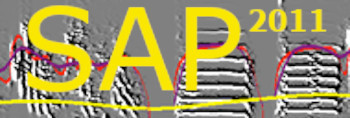Cummulative DVD maps
| < PREVIOUS: 2-D DVD maps | > NEXT: Syntax DVD maps |
|
|
|
|
I Looking at the movie, you can see how clusters (syllable types) emerge and change with development. In order to obtain some solid evidence to this change, it is often useful to compare two 'frames' of the DVD map. To best observe the long-term effect of time on the distribution of syllable features, select 'color by linear time' from the color scheme, move the 'Time control' slider to the beginning of song development and then select the 'cumulative movies' tab. Select duration for the X axis and FM for the Y axis. In the marker size selection, click 'tiny' and then click 'DVD Play/Stop' to start the movie. Color will slowly change from yellow to red. The little slider to the right of the 'color by linear time' control can be used to change this rate. The result should look like the figure below. Note that you can also change colors manually at any time during the movie, as well as moving the 'Time control' slider to different developmental time, either during play or offline.
 Changes in feature distribution occur also during short time-scales, e.g., after night sleep or during certain hours of the day. Click 'clear' and change the color scheme to 'color by time of day'. SA+ will now code circadian time by color - red for early morning, orange for late morning, green for noon, blue for the afternoon and black for the evening song. Set the time control to late song development and click 'DVD Play/Stop'. You should be able to see how the duration fluctuates with the time of day. Looking at other features during early development will show even stronger changes - try the Wiener entropy variance. Feel free to switch back and forth between dynamic movies and cumulative movies on the fly.
|
|
